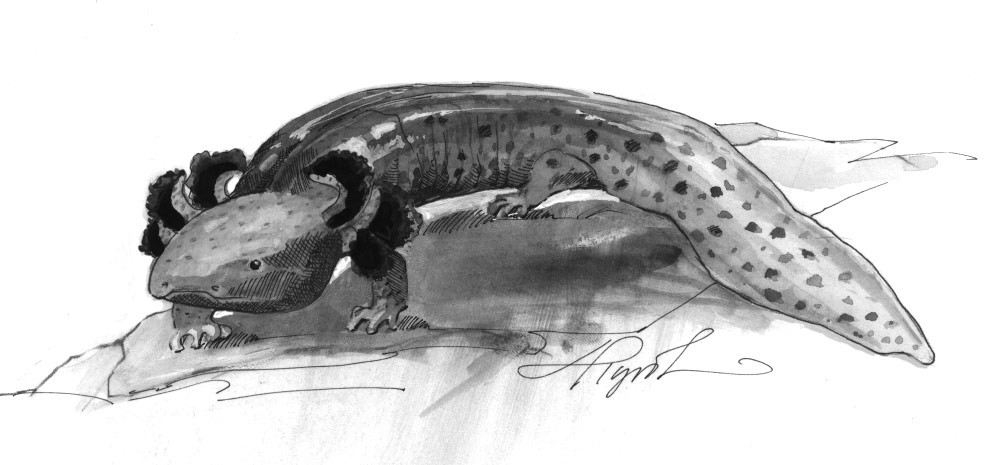
What are we to make of the Connecticut River mudpuppies?
And what is a mudpuppy, anyway? It is not a dirty dog. It’s not a canine of any sort. It is a salamander, and a big, ugly salamander at that. Salamanders are amphibians, but unlike most amphibians, a mudpuppy lives its entire life in water.
At 12 to 14 inches long, mudpuppies are about twice the size of the other salamanders in our region. They have reddish, feathery gills, which they seem to be wearing like a boa around their necks. Every once in a while an angler finds a mudpuppy on the end of his or her line. Ice fishermen, in particular, seem to have a knack for catching these creatures.
Most people, however, have never seen a mudpuppy. Those who do often guess that they have captured a “missing link” between fish and land animals.
But mudpuppies are not a missing link. They start their lives as eggs attached to the underside of rocks. They hatch as little swimming creatures, just as all amphibians do. They develop lungs and legs, just as amphibians do. At the point that most amphibians lose their gills and leave the pond or the river, though, mudpuppies stay put. They keep their gills, and they use their lungs for buoyancy. They keep their flattened tail and continue to use it for swimming.
The mudpuppy doesn’t represent a missing link as much as it does a U-turn. It is not the only salamander with an offbeat life cycle. In our area, the Eastern newt returns to the water after a walkabout, subadult, eft stage. In the Midwest, the hellbender is also totally aquatic and is even bigger than the mudpuppy, although it doesn’t wear its gills around its neck as the mudpuppy does.
In Vermont, west of the Green Mountains, mudpuppies are at the eastern edge of their range. That range centers on the Ohio River drainage. Because they are totally aquatic, if a mudpuppy can’t swim to a lake or river from the Ohio River watershed, it probably was never native to it.
Which brings us back to the Connecticut River. Mudpuppies were first described in the river in 1875, yet there is no water link between the Ohio River drainage and the Connecticut River. Could these secretive creatures, which are active at night and are at least as active in the winter as the summer, have been there all along? Were they simply overlooked, in the age before flashlights?
While some scientists say that is so, Alan Richmond thinks not. Richmond is a herpetologist at the University of Massachusetts-Amherst. He is curious about mudpuppies and has long studied amphibian distribution.
Richmond has read a lot of old scientific papers in an effort to solve the mystery of the Connecticut River mudpuppies. In 1842, a scientist named James DeKay wrote that there were no mudpuppies in the Hudson River or its tributaries, but that he expected to find them soon after the Erie Canal connected the Hudson to the St. Lawrence River watershed, where mudpuppies are native.
Richmond explains that introduced species usually go through an initial spike in population. They are introduced; their population explodes; then it crashes down.
Sure enough, in the 1890s, mudpuppies were abundant enough in the Hudson River that they gushed out of fire hydrants in Albany, New York.
There was a similar explosion of mudpuppies in the Connecticut River around 1930. Richmond found a record of mudpuppies clogging pipes at the Connecticut River oxbow in Northampton, Massachusetts.
That the mudpuppy population in the Connecticut River appears to be centered near Amherst, Massachusetts – extending north into Vermont and New Hampshire near Vernon, Brattleboro, and Putney – is an important clue, Richmond believes.
Another population is found in the river near Hartford, Vermont, and Lebanon, New Hampshire.
It appears the mudpuppies in the Connecticut River are salamanders with a college education. Mudpuppies are commonly used as laboratory animals and for dissections. Apparently, they offer a little variety to students who have already aced their frog dissections.
These study animals sometimes escape and sometimes get dumped into the nearest body of water. There is good documentation of escaped mudpuppies destined for use in Colby College classes making a home in a series of lakes in Maine.
Richmond’s best guess is that the Connecticut River mudpuppies are also escapees, perhaps from science classes at Amherst and Dartmouth colleges. He hopes to find funding to analyze the DNA of mudpuppies in the river to test his theory.
But even if Richmond solves the mystery of the Connecticut River mudpuppies, it’s unlikely that we’ll ever know all the secrets of this giant, feather-boa wearing, college-attending, winter-active salamander.


Discussion *